#OBC reservation
Text
Soren Likens BJP Leaders to "Political Vultures" Pre-Election
CM criticizes opposition for divisive tactics at Giridih district event
Key Points:
• Hemant Soren accuses BJP of misleading masses on religious and caste lines
• CM alleges obstacles in scheme implementation by opposition
• Soren highlights government’s efforts in employee welfare and development
RANCHI – Jharkhand Chief Minister Hemant Soren has launched a scathing attack on BJP leaders,…
#राज्य#BJP Criticism#CM Mainyan Sammaj yojana#development schemes#Giridih district#Hemant Soren#Jharkhand elections#OBC Reservation#political vultures#Sarna Religion Code#state
0 notes
Quote
Various surveys have confirmed that the other backward classes, Scheduled Castes and Scheduled Tribes are over-represented in the proportion of poor. The forward caste groups are considerably better off as a class or group, even if there are poor individuals amongst them. Therefore, the reservation has always dealt with class poverty. By determining a class on the basis of economic criteria – income below Rs 8 lakh per annum of a family or individual – the EWS quota, ex facie, infringes the principles of constitutional equality and renders the concept of reservation, as known to the Indian Constitution, virtually unrecognisable. In short, EWS is ambiguous, arbitrary and alien to the established principles of constitutional equality.
Manuraj Shunmugasundaram, ‘EWS judgment is a setback to social justice, India’s constitutional scheme’, Indian Express
#Indian Express#Manuraj Shunmugasundaram#OBCs#SCs#STs#India#poverty#class poverty#economic criteria#reservation#EWS quota#constitutional equality#Indian Constitution
3 notes
·
View notes
Text
सामान्य सीट पर ओबीसी, एससी और एसटी के छात्र ले सकते है एडमिशन; सुप्रीम कोर्ट का आरक्षण पर बड़ा फैसला
Supreme Court on Reservation: सुप्रीम कोर्ट ने मंगलवार को आरक्षण को लेकर एक बड़ा फैसला सुनाया। देश की सर्वोच्च अदालत ने मध्य प्रदेश हाईकोर्ट के उस फैसले को रद्द कर दिया, जिसमें आरक्षण का लाभ ले रहे मेधावी छात्रों को सामान्य श्रेणी की सीट पर दाखिला नहीं देने का फरमान सुनाया गया था।
सुप्रीम कोर्ट ने अपने फैसले में कहा कि अन्य पिछड़ा वर्ग (ओबीसी), अनुसूचित जाति (एससी) और अनुसूचित जनजाति (एसटी) वर्ग…
#admission#decision#delhi news#general seats#india news#OBC#reservation#reservation news#SC#ST#Students#Supreme Court#supreme court news
0 notes
Text
மறுக்கப்படும் OBC மக்களின் உரிமைகள் - உச்ச நீதிமன்ற தீர்ப்பு எதிரொலி!
youtube
#sfrbc#tnsfrbc#backwardcommunity#reservation#coimbatore#bc#obc#fightforrights#legalrights#fightforjustice#socialjustice#Corruption#supremcourt#PMmodi#castecensus#sc#st#youth#sudents#education#viral#trendings#mkstalin#BJP#DMK#Congress#Youtube
0 notes
Text
dude I can't do this anymore psych majors need to compulsorily read ambedkar and jyotiba phule among other anticaste lit bc some of the comments I've seen from general category people coping from not getting into their preferred institutions have been vile. this from the potential mental health caregivers of this country.
#personally being a psych-socio double major even sociology mfs fail to understand reservation machinery and its significance#like I'm technically obc but my parents never had our caste certs made bc they don't care about caste + we r well off#the entire idea is that reservations are a temporary solution so ofcourse it won't be perfect but guess what you literally have good privat#institutions to choose from. some that offer 100% scholarship too. and ur still whining#saw a cope so bad on TL i HAD to chuckle bc she wasn't getting into this clg that I had already rejected my seat of.#put her own ass on blast too by posting her score as proof. tbh should've known you won't get anywhere with a score less than 240/300. lol#randomeows
0 notes
Text
#obcrights#reservationforobc#reservationintamilnadu#localrevenuedepartment#revenuecertificates#abadomdedwomen#reservation for obc
0 notes
Text

Reservation in India: Know everything about the Reservation system in detail
As soon as India gained independence, reservations were incorporated into the constitution to acknowledge the historical injustice done to members of underprivileged groups and to put policies in place to give them better access to resources and opportunities.
In India, reservations were first implemented:
To make amends for historical wrongs committed against India’s lower classes
To guarantee that individuals from all castes are equally represented in the state- and federally-funded programs
To provide everyone with a level playing field regardless of caste
To uplift and improve the underprivileged groups
“Let us understand the whole concept of Reservation in detail. This article includes the provisions related to Reservations, a brief history, and some landmark cases.”
Reservation system in India
In India, reservations are a form of affirmative action that works to give a predetermined number of seats in social and educational institutions to various underrepresented communities. It is made in response to the discrimination by members of upper castes in India. As a result, when India won independence, the constitution included a clause requiring a certain community to have a certain level of representation in various sectors.
Caste reservation in India
Reservations under the Constitution for socially and economically disadvantaged groups are intended to give those members of the scheduled castes and scheduled tribes access to jobs and education.
Why is there a reservation in India?
The main aim of the Indian Constitution is to provide a certain level of security to the citizens of India regarding equality of status and opportunity and to promote all fraternities, assuring the dignity of the individual and the unity and integrity of the nation (as stated in the preamble).
When did the SC ST reservation start in India?
Reservation was a known concept in India for a very long period. Let’s know the history of reservations in India.
Reservation was there at the time when the Britishers ruled India.
It is generally thought of as who decides on a reservation in India. Originally, William Hunter and Jyotirao Phule in 1882 conceived the idea of a caste-based reservation system. When the Hunter Commission was established in 1882, Mahatma Jyotirao Phule urged that all citizens have free, mandatory education and government employment.
In 1902, a notification established 50% of service reservations for economically disadvantaged people in the state of Kolhapur. This was India's first notification establishing a reservation for the benefit of the country's underprivileged.
Reservation was instituted in 1908 in support of the castes and communities that participated in the administration under British rule.
The Morley Minto Reforms, also known as the Government of India Act of 1909, contained provisions made in 1909.
The Government of India Act of 1919 introduced provisions for reservation in 1919.
A GO issued by the Madras Presidency in 1921 allocated 44% of reservations to non-Brahmins, 16% to Muslims, 16% to Anglo-Indian Christians, and 8% to Scheduled Castes.
The Government of India Act 1935 included provisions for the reservation in 1935.
Our Indian Constitution took effect on 26 January 1950.
Following independence, the Constituent Assembly, presided over by Dr BR Ambedkar, established the system of reservations. It was first made available for ten years. After ten years, Indian legislators recognized the necessity to retain the system of reservations in place to address decades of racial and cultural prejudice against particular groups in society.
To continue reading, click here.
0 notes
Text
Social Justice Warrior: Thanthai Periyar’s Struggle for All-India OBC, SC, and ST Reservation in Education | History behind Social Justice Day — Rational Sapien.
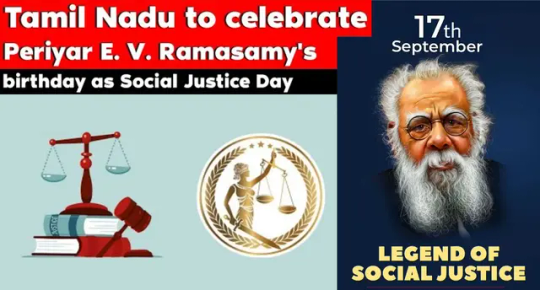
Thanthai Periyar, also known as E. V. Ramasamy, was born to a wealthy merchant in Erode and lived in opulence. In his early days, he was attached to the Indian National Congress and the Khadi movement. He carried Khadi clothes on the streets and sold them, and moved his family to a simpler life.
As a nationalistic Congress leader, Periyar carried bundles of Khadi clothes on his shoulders with the hope of bringing social justice alive. He focused on passing a bill on “Communal Representation” to ensure fair representation for non-Brahmins in government and other institutions. He carried copies of the bill in his hands for five consecutive Congress conferences.
However, due to the heavy Brahmin dominance in the party, his bill was not passed. Instead, the Brahmins twisted his “Community based Representation Bill” as a form of “Divisive communalism”. Periyar realized that the Congress movement was the “fort of Brahminical supremacists.”
Periyar was a powerful and wealthy man, but he gave up everything to fight for social justice. He resigned from his 26 positions, including that of Erode City Council president, to join the Congress party. Later, when he realized that the Congress was not committed to social justice, he left the party in 1925. He said, “If the nation was liberated without social justice, it would only benefit the dominant caste (Brahmins).”

Rettaimalai Srinivasan (left), Justice Party leaders - P. Theyagarayar & Dr. T.M Nair, Periyar ( DK @ Dravidar kazhagam), Arignar Anna ( Dravidar Munnetra Kahzagam @ DMK)
During British rule in the 19th century, Brahmins dominated all fields. The fight for caste-based reservation has a long history, starting with Ayothidasa Pandithar’s call for non-Brahmins to have the right to employment in 1891, and continuing with the Justice Party in 1916.
The Justice Party pioneered social justice in South India by implementing reservation for non-Brahmin communities in 1916. This paved the way for inclusive growth. Brahmins claimed that giving equal representation to all communities was “divisive communalism” to maintain their own power and privilege.
The Justice Party came to power with the support of the people and the Council of Ministers led by King Panagal presented the bill in the Legislative Assembly in August 1921. This draft law was notified as a Government Ordinance Communal G.O 613 (16.9.1921) and a committee consisting of legislators was constituted to monitor the proper implementation of the Ordinance.
After this, on August 15, 1922, an ordinance was promulgated to provide class representation in educational institutions, but this ordinance was stalled due to the conspiracy of the Brahmins. The fact that what happened on that day was the lack of support from the governor and the white ICS officials. Hindu, Sudeshamitra etc. Brahmins wrote strongly against it.
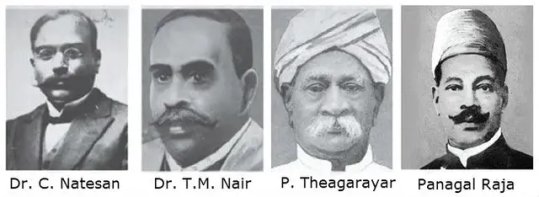
Justice Party Leaders
The Justice Party lost the third election in 1926. There was a dispute among the majority Swarajya Party over who would be the Chief Minister. Therefore, the Swarajya Party brought P. Subbarayan from the Justice Party and asked him to form an independent cabinet so that the Justice Party should not form the cabinet. Similarly, he formed a cabinet with himself as the Chief Minister and Swarajya Party member A. Ranganatha Mudaliar and RN Arokiasamy Mudaliar as ministers and took over the government on 4.12.1926. The Swarajya Party dreamed of winning Subbarayan away from the Justice Party and bringing it to their side. However, he also led the government after listening to the Justice Panagal, who was the leader of the opposition party. Therefore, his regime is considered as a Justice Party regime.
Suppurayan, a former Justice Party member, was supported by both the Swarajya Party and the Congress Party, but Suppurayan took office as Chief Minister in August 1927 when he moved a motion of no confidence in the Subpurayan cabinet, which was defeated with the support of 14 members of the Justice Party.

Paramasivam Suppurayan, a former Justice Party member successfully implemented Communal G.O with the help of Justice Party in 1928.
S. Muttiah Mudaliar left the Congress party opposing the Congress’s pro-brahmin activites and join the Suppurayan cabinet. He was the first to introduce the new Caste Reservation Act in the Madras Provincial Assembly on 04.11.1927. The Suppurayan Cabinet issued a new order for caste reservation in 1927 (G.O. M.S. No 1021).
On January 28, 1928, Subparayan did not accept the resolution passed by the Swarajya Party in the Legislative Assembly to ignore the Simon Commission. So two ministers belonging to the Swarajya Party resigned and therefore got the support of the Justice Party Suppurayan became Ministers in his cabinet S. Muthiah Mudaliar and MR Sethuratnam Iyer. Justice Party and Self-Respect Movement as their commander Soundarapandian came to the Suppurayan cabinet as the whip of the ruling party. Soundarapandian built this cabinet like a fortress.
This cabinet came into charge on 16 March 1928. This cabinet is also considered as the Justice Party cabinet.
This Cabinet passed Communal Ordinance №744, dated 13.9.1928. This order issued by S. Muthiah Mudaliar for the first time defined this number of places for all the communities. Yes, S. Muthiah Mudaliar, a non-Brahmin, issued this “Community based Reservation for all Government jobs” in 1928 providing 100% reservation for the entire population, including Brahmins, non-Brahmins, and minorities.

Community Based Reservation implemented by Suppurayan Devised by Justice Party in 1926.
After the implementation, Periyar pointed out some of the issues in the Communal Go G.O. M.S. No 1021.
Minister S. Muthiah Mudaliar brought this Communal Ordinance for the Registration Department he was holding. But, Periyar wrote in the “Kudiarasu” that communal representation should be implemented in all sectors. Accepting Periyar’s order, the Subbarayan cabinet issued this order in other departments as well. By these orders, non-Brahmins got reservation in government jobs. Thus Periyar enriched communal representation. Periyar praised this as “long live Muthiya Mudaliyar!” in Kudiarasu Editorial Magazine.
Periyar’s campaign progressed by demolishing the Brahminical structure by exposing the Brahmins’ conspiracy in his editorials and articles in the Kudi Arasu newspaper. Thanthai Periyar used his power and authority in the Madras province to educate all non-Brahmin communities about the true purpose of community-based reservation.
People who say that Periyar wasn’t important for social justice don’t understand how he changed people’s minds.
Periyar started the Self-Respect Movement in 1925, the same year as the Indian National Congress. He worked hard to expose the harmful structures of these systems to the people.He played a big role in social justice because of the ways he showed people how caste, religion, piety, superstitions, misogyny, ritualism, and formalism were harmful and kept people from respecting themselves.
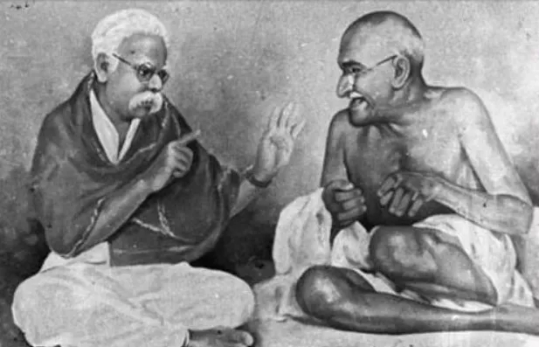
Periyar Left congress & Started Self Respect movement in 1925.
Periyar didn’t just go to public meetings but also to caste groups meetings. He spoke at caste conferences. Talking to caste groups is like handling a double edged knife But Periyar handled it tactfully. Periyar made miracles by changing the caste mindset into an egalitarian mindset and asking for the rights due to their caste.
Beginning in 1925, he addressed more than ten caste conferences covering the majority of the population. In particular, the conferences of castes like Nadar, Sengundar, Vanniya Kula Chatriyas, Chettiars, Pallars and Adi Dravidians are included in it.”
A caste conference should be convened to take the shortcomings of each caste to the government. If you call me to caste conferences, I will talk about everything and Caste annihilation. He was the one who said that the cruelty of one being superior and one being inferior taught by the Varnashrama Dharma should be eradicated.
He also expressed the shame of having caste Pride. At the same time, he also spoke for rights that were denied in the name of caste. He brought egalitarianism and social justice rights so subtly in the People’s Forum.
After India’s independence, Periyar held caste abolition conferences in a political environment where people developed caste pride out of greed for position and power. Periyar always talked about social justice rights at all conferences, no matter whether they were caste Group conferences or caste abolition conferences.
The Justice Party was able to bring about social change by implementing community-based reservation under British rule through dual rule system. Even after Justice Party, this system of reservation continued till 1950.
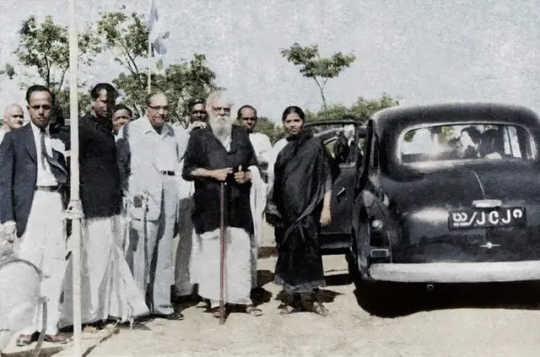
Babasaheb Ambedkar & Thanthai Periyar E V Ramasamy
The Constitution enacted on January 26, 1950, by the intellectual revolutionary Ambedkar, provided for reservation in employment only, but there was no reservation in education. After Independence, Brahminism made its first major attack on social justice brought by Justice party.
It was then that the greed of the brahmins made them gobble up the reservation reserved for the brahmins themselves. Sembagam Durairajan and Srinivasan case played a major role in that. They said “Both of them didn’t get seats in medical college and engineering college respectively”. They filed a case in the Madras court claiming that this was against the fundamental provisions of the Constitution.
After hearing the case of these two, the court found that “Sembagam Durairajan did not apply to the medical college and Srinivasan falsely reported that he did not get a seat even after 14.29% of the reserved engineering seats for Brahmins were filled.” Through their Greediness, the wish of the Brahmins was fulfilled. On 27.07.1950, The Madras High Court struck down the Madras Province’s “Community-based Reservation Rights Act in Education and Employment” Act, which was in implementation from 1924 to 1950, as unconstitutional. The Supreme Court also gave the same verdict.
How will Periyar, as a man who threw away his prosperous life and positions in Congress fighting for the right of social justice for all oppressed castes, accept this verdict?.
14th August in 1950, Periyar launched agitation and gave the clarion call to the people of Tamil Nadu to express protest by declaring “Communal Reservation Day”. The protest was against the judgment given by Supreme Court of India that stayed the Communal Reservation Policy implemented in Madras Presidency right from 1928. On 07.08.1950 at Robinson Park, Chennai, 50,000 people attended the meeting and Periyar invited people from all walks of life to fight.
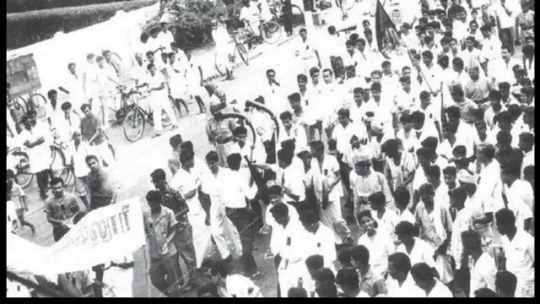
Chennai Pachaiyappa’s College Students joined the protest with Periyar.
On 14th August (1950), Accepting Periyar’s invitation, various students staged a protest. Students of Chennai Pachaiyappa’s College protested against the court order. Periyar’s Call ignited Total agitation in Tamil Nadu in all sectors and all sections of people including students, teachers, doctors, govt. servants, all non-brahmins joined the struggle.
The slogans of “Abolish the political law, want communal rights” chanted by the entire gathering echoed up to the Delhi Union government.
On December 3, 1950, in Trichy, Periyar gathered all-party communal rights supporters including Perarignar Anna (DMK), Kamarajar, and convened a communal conference at Periyar House. He conducted a conference and said, “You have given four water pipes with taps to the streets; but you have not given the water supply to that tank! We have been given reservation for employment, but we have not studied yet. Then, how can we go for job opportunities?”. Periyar passed the Communal G.O.
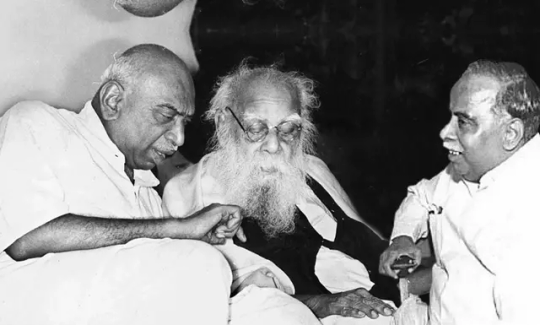
Kamarajar (Left), Thanthai Periyar (center), Perarignar Anna (right).
Tamil Nadu registered its protest that students are protesting and shutting down shops everywhere in Tamil Nadu. They protested by showing black flag to Union Ministers. On the other hand, Kamaraj and Sardar Vallabhbhai Patel conveyed the Seriousness & strength of Periyar’s Protest to the the Prime Minister of the India, Jawaharlal Nehru. Ambedkar also registered his opposition.
Periyar’s voice spread not only to the ears of the Delhi Union government but also to the people about the necessity of reservation in education. Periyar’s agitation forced the Nehru government to come down on education reservation.
The first amendment was tabled in Parliament by Chief Minister Pandit Jawaharlal Nehru on 10.05.1951. Including Education reservation, a total of 14 amendments were made in the Constitution through a single proposal. Nehru mentioned this in his introductory speech on the amendment. “Protests in Madras province lead us to amend the law”. Parliament passed it on 18.05.1951 with an overwhelming majority and made it law.
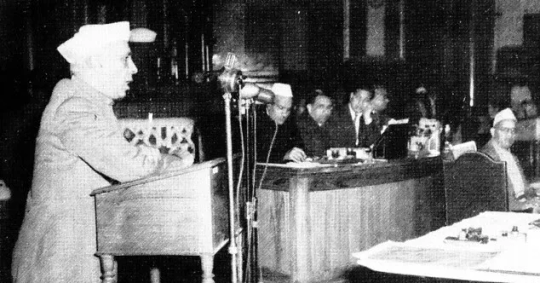
First Constitutional amendment by Chief minister of India, Pandit Jawaharlal Nehru.
In order to overcome the verdict in the Champakam Durai Rajan case, the Parliament brought in the First Amendment Act, 1951 and inserted clause 4 to Article 15. The provisions of this clause are in the nature of an enabling provision (allows, felicitate) and do not impose any obligation on the State to take any special action under it. It merely confers discretion to act if necessary by way of making special provisions for socially and educationally backward class and Scheduled Castes and Scheduled Tribes.
Article 15(4) : “neither clause of this Article 15 nor Clause 2 of Article 29 shall prohibit the State from making any special provision for the advancement of any citizen of socially and educationally backward classes or of Scheduled Castes and Tribes”
Until then, Article 16(4) ensured reservation only in case of employment. Reservation in education came only after the First Amendment, which ensured reservation for backward, scheduled, and minority communities across the country by the Union and State Governments. Through the efforts of Periyar and the DMK, the addition of Section 15(4) to the Indian Constitution paved the way for the Mandal Commission protests by periyarists and the implementation of all-India OBC reservation in education by V.P. Singh.
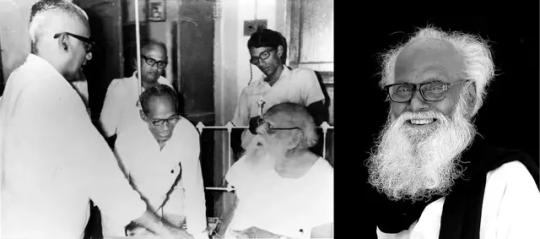
V Anaimuthu (centre) receives permission from Periyar to publish his thoughts.
When Periyar passed away in 1973, Anaimuthu, A periyarist, continued the struggle for social justice of backward classes. Anaimuthu parted ways with the D.K and formed the Periyar Sama Urimai Kazhagam (Periyar Equal Rights Kazhagam) which took up reservation as their main agenda. Between 1976 and 1982, Anaimuthu conducted his campaign for reservation in education and employment in the Central government. In Bihar, their volunteers filled the prison as part of this demand. He took the struggle to New Delhi. The Mandal Commission was formed because of these pressures.
Anaimuthu made sure the Mandal Report was released in Parliament in 1980, thanks to which 50 per cent reservation for the Backward Classes was passed. But it was not implemented as promised, hence he began to meet Members of Parliament from 1981 onwards. In 1990, the then Prime Minister V P Singh announced in the Parliament that the recommendations of the Mandal Commission would be implemented Which provides 27% reservation for OBC’s on top of 23% reservation for SC and ST in India.
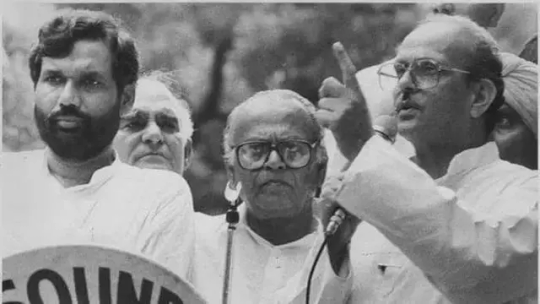
Former Prime Minister V.P. Singh addressing a rally about implementation of the Mandal Commission Report in August 1990
Indira Sawney challenged the Mandal Commission and government decision to implement the OBC Reservation by V.P.Singh in the Supreme Court. In 1992, All India OBC reservation was implemented after Indira Sawney case was Closed with a provision that maximum reservation can be 50% of the educational seats or job vacancies and creamy layer of income of ₹8 lakhs per year. Anaimuthu’s untiring effort to implement the Mandal Commission report in this decade is a milestone in Indian history.
There are so many leaders who have made the government realize the right of social justice. But Periyar was the foremost among the leaders who spread the importance of Social Justice through reservation to the people and even today his followers ensure the
Periyar was a tireless advocate for the rights of the oppressed and backward people in the People’s Forum, touring all the nooks and corners of Tamil Nadu to the extent that he gave up his elite life. People say, “There was no place in Tamil Nadu where Periyar did not set his feet.” Periyar was an uncompromising opponent of the Brahminical intrigue against social justice reservation in the political arena. Social justice is the tool that Periyar used in his political arms to pave those paths against Brahminical intrigue and restore the social rights of the Tamil Nadu. Calling the social justice hero Thanthai Periyar’s birthday as Social Justice Day is a small thank-you to him for his lifelong struggles for the majority oppressed castes.
“One comes to school for training to acquire merit and skill. But if you need a qualification and skill even to study and get training, this is foolishness,” said Periyar. The ruling union government is keeping the meritorious children of our children by imposing merit tests like NEET to protect the power structures of Brahminism. Let us stand on the path of Periyar, who stood for social justice, and take a pledge to eliminate the anti-social justice selection criteria on this Social Justice Day.
#Periyar#Dravidian#Education Reservation#All India OBC SC ST Reservation#E V Ramasamy#First Constitutional Amendment#Indian Educational Reservation#Dalit Rights#Babasaheb Ambedkar
1 note
·
View note
Note
Hi, what do you think about the reservation for SC/ST and OBC for entrance exams and seat allotment? It feels unfair for the general category people. I see that you don't support caste based discrimination and seem to have read quite a bit about it so I just want to know your opinion and hear a perspective from someone who knows more about the topic.
Hoping that you'd answer this ask. Thank you!
P.S- I enjoyed scrolling through your blog so much during the elections results.
prefacing this with the disclaimer that I don't just oppose caste based discrimination, I want the complete abolition of caste. it is a bullshit social order and there's nothing that could ever justify its existence it is nothing short of rotten and dehumanising
in the nicest way possible, i'd like to challenge your notion of reservations being unfair to general category people. they make up what, 25% of india's population? they're an overrepresented statistical minority. the rest of the population are sc/sts, obcs and muslims. ideally, this ratio would be reflected in institutions, where instead you see an overwhelming majority of both students and teachers being upper caste hindus because of the way caste apartheid works
sure you could point out issues in the implementation of reservation policies. at the same time the problem does not inherently lie in reservations. the solution would not be to reduce or completely remove reservations. whatever faults lie in the functioning of reservation schemes aren't on the people who avail them btw they are not seat stealers or freeloaders they are people exercising their fundamental human right to education and other facilities, ones that they've been denied for ages
you might say that people who got admission through reservations are untrustworthy because people should be selected on the basis of how deserving and capable they are, unlike the ones who got in this way, yes? but do you seriously believe that in a true, genuine meritocracy, this tiny statistical minority would overtake or overpower quite literally everyone else? or that they're inherently superior and more capable? the same courtesy isn't extended to people who get admissions through management quota, why is it only sc/sts who are questioned on their excellence and capabilities?
think about it.
48 notes
·
View notes
Text
How Jammu and Kashmir Bills Passed by Modi-Shah Government Will Transform the Region
We hope you enjoyed reading this article and learned something new. Please share your feedback, questions, or comments below. We would love to hear from you.
In this article, you will learn about the two historic Jammu Kashmir Bills Modi Shah government passed in the Lok Sabha that aim to address the long-standing issues in Jammu and Kashmir. You will also discover the history, administration, and strategic significance of PoK, the region that has been a bone of contention between India and Pakistan for decades. Read on to find out how these bills…

View On WordPress
#amit shah#Jammu and Kashmir#Jammu-kashmir-bills-modi-shah#Jawaharlal Nehru#Kashmiri Pandit exodus#OBC reservation#PoK#Reorganisation Bill#Reservation Bill#Terrorism in J&K
0 notes
Text
People who benefit from casteism aren't bramhins 90 percent of the time, it is the vaishyas, i.e shopkeepers and land-owning farmer class who benefit off dalit farm labourers and poor dalit customers. Often, it is people call themselves "lower caste" by virtue of being down in the heirarchy; they benefit from caste reservations made for dalits while still opressing dalits. Often, and this can be a hard concept to digest, often they are ones who have succeeded in getting OBC certification in many states, so they are able to posture as dalit when it benefits them socially and politically and yet very actively perpetuates the cycle of opression on dalits.
It benifits caste-deniers to present casteism as bramhins vs. non-bramhins but it's important that we never forget what it really is: dalit vs. non-dalit.
#“speaking as a lower caste person” shut up.#see how modi benifits off his OBC? that is exactly what i mean#casteism#anti caste#anti hindutva#india
19 notes
·
View notes
Text
देश में सरेआम छीना जा रहा एससी, एसटी और ओबीसी का आरक्षण, शीर्ष नौकरशाहों में नहीं है प्रतिनिधित्व; राहुल गांधी
Rahul Gandhi: कांग्रेस नेता राहुल गांधी ने एक बार फिर आरक्षण को लेकर मोदी सरकार पर निशाना साधा है। राहुल गांधी ने कहा कि एससी, एसटी और ओबीसी वर्ग का आरक्षण खुलेआम छीना जा रहा है। शीर्ष नौकरशाही समेत देश के तमाम शीर्ष पदों पर वंचितों का प्रतिनिधित्व नहीं है।
राहुल गांधी ने रविवार को सोशल मीडिया पर एक पोस्ट में कहा कि नरेंद्र मोदी संघ लोक सेवा आयोग के बजाय ‘राष्ट्रीय स्वयंसेवक संघ’ के माध्यम से…
0 notes
Text
How thrives the OBC is denied Jobs and Scholarships?
youtube
#tnsfrbc#tamilnadu#students#school#rain#12thresult#10thresult#result#election2024#obcrights#motivation#obc#sc#st#reservation#summer#justice#law#flood#injustice#india#agriculture#Youtube
0 notes
Text
Creamy layer is a term used in Indian politics to refer to some members of a backward class who are highly advanced socially as well as economically and educationally. They constitute the forward section of that particular backward class – as forward as any other forward class member.[1] They are not eligible for government-sponsored educational and professional benefit programs. The term was introduced by the Sattanathan Commission in 1971, which directed that the "creamy layer" should be excluded from the reservations (quotas) of civil posts. It was also identified later by Justice Ram Nandan Committee in 1993.
The creamy layer (income) criteria were defined as the gross annual income of parents from all sources more than 100,000 rupees (₹ or INR defined by Sattanathan Committee in 1971) In 1993 when "creamy layer" ceiling was introduced, it was ₹ 1 lakh. It was subsequently revised to Rs 2.5 lakh per annum in (2004), and revised to ₹ 4.5 lakh (2008),[2] Rs 6 lakh (2013)[3][4] and Rs 8 lakh (2017).[5] In October 2015, the National Commission for Backward Classes (NCBC[6]) proposed that a person belonging to Other Backward Class (OBC) with gross annual income of parents up to Rs 15 lakh should be considered as the minimum ceiling for OBC.
2 notes
·
View notes